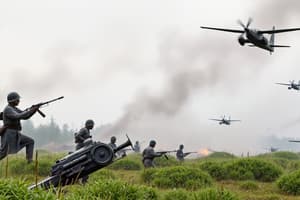Podcast
Questions and Answers
What was the primary goal of appeasement during the Munich Conference?
What was the primary goal of appeasement during the Munich Conference?
- To support the Soviet Union against Germany
- To establish new borders in Europe
- To prevent a larger conflict by accommodating demands (correct)
- To encourage military alliances against Germany
What tactic did Hitler's army employ during the invasion of Poland?
What tactic did Hitler's army employ during the invasion of Poland?
- Trench warfare
- Guerrilla warfare
- Scorched earth
- Blitzkrieg (correct)
What did the U.S. Lend-Lease Act of 1941 enable the United States to do?
What did the U.S. Lend-Lease Act of 1941 enable the United States to do?
- Join the war on the side of the Axis Powers
- Establish a military base in Europe
- Provide military supplies to Britain while remaining neutral (correct)
- Enforce trade restrictions on Germany
What was the purpose of the Maginot Line in France?
What was the purpose of the Maginot Line in France?
What significant event occurred on June 4, 1940?
What significant event occurred on June 4, 1940?
What was the significance of the Nazi-Soviet Non-Aggression Pact?
What was the significance of the Nazi-Soviet Non-Aggression Pact?
What was the result of Executive Order 9066 signed by FDR?
What was the result of Executive Order 9066 signed by FDR?
Who were the leaders referred to as the 'Big Three' during World War II?
Who were the leaders referred to as the 'Big Three' during World War II?
What was the size of the German Army during the Battle of Stalingrad?
What was the size of the German Army during the Battle of Stalingrad?
Which of the following was NOT a component of the Russian Army during the Battle of Stalingrad?
Which of the following was NOT a component of the Russian Army during the Battle of Stalingrad?
What was a consequence of the internment of Japanese Americans during World War II?
What was a consequence of the internment of Japanese Americans during World War II?
Which of the following statements about the Axis Powers in 1942 is true?
Which of the following statements about the Axis Powers in 1942 is true?
Which battle marked a significant turning point on the Eastern Front in early 1943?
Which battle marked a significant turning point on the Eastern Front in early 1943?
How many planes did the German Army have during the Battle of Stalingrad?
How many planes did the German Army have during the Battle of Stalingrad?
What was the Sudetenland?
What was the Sudetenland?
Which event is recognized as the trigger for the start of World War II?
Which event is recognized as the trigger for the start of World War II?
What role did the Munich Conference play in the context of World War II?
What role did the Munich Conference play in the context of World War II?
What was the primary aim of the U.S. Lend-Lease Act?
What was the primary aim of the U.S. Lend-Lease Act?
Which country occupied the Sudetenland as a result of the Munich Conference?
Which country occupied the Sudetenland as a result of the Munich Conference?
In what year was the U.S. Lend-Lease Act enacted?
In what year was the U.S. Lend-Lease Act enacted?
What was a significant consequence of the Munich Conference?
What was a significant consequence of the Munich Conference?
What was one major means of supply used in the U.S. Lend-Lease Act?
What was one major means of supply used in the U.S. Lend-Lease Act?
Flashcards
Japanese Internment
Japanese Internment
A policy during WWII that required all people of Japanese descent, regardless of citizenship status, to be placed in internment camps. This included thousands of US citizens.
The Big Three
The Big Three
The three key leaders of the Allied powers during WWII: Winston Churchill (UK), Franklin D. Roosevelt (US), and Joseph Stalin (USSR).
Axis Powers in 1942
Axis Powers in 1942
The group of nations that opposed the Allied powers during World War II. This included Germany, Japan, and Italy.
Battle of Stalingrad
Battle of Stalingrad
Signup and view all the flashcards
German Army Numbers at Stalingrad
German Army Numbers at Stalingrad
Signup and view all the flashcards
Russian Army Numbers at Stalingrad
Russian Army Numbers at Stalingrad
Signup and view all the flashcards
Losses at Stalingrad
Losses at Stalingrad
Signup and view all the flashcards
Stalingrad: A Turning Point?
Stalingrad: A Turning Point?
Signup and view all the flashcards
Appeasement
Appeasement
Signup and view all the flashcards
Maginot Line
Maginot Line
Signup and view all the flashcards
Invasion of Poland
Invasion of Poland
Signup and view all the flashcards
Blitzkrieg
Blitzkrieg
Signup and view all the flashcards
Dunkirk Evacuation
Dunkirk Evacuation
Signup and view all the flashcards
Nazi-Soviet Pact
Nazi-Soviet Pact
Signup and view all the flashcards
What was the Sudetenland?
What was the Sudetenland?
Signup and view all the flashcards
What was the Munich Conference?
What was the Munich Conference?
Signup and view all the flashcards
What was appeasement?
What was appeasement?
Signup and view all the flashcards
What officially started World War II?
What officially started World War II?
Signup and view all the flashcards
What was the U.S. Lend-Lease Act?
What was the U.S. Lend-Lease Act?
Signup and view all the flashcards
Why was the U.S. Lend-Lease Act significant?
Why was the U.S. Lend-Lease Act significant?
Signup and view all the flashcards
Why did the U.S. provide supplies to Britain?
Why did the U.S. provide supplies to Britain?
Signup and view all the flashcards
What was the impact of the U.S. Lend-Lease Act?
What was the impact of the U.S. Lend-Lease Act?
Signup and view all the flashcards
Study Notes
The "Problem" of the Sudetenland
- Land given to Czechoslovakia after the Treaty of Versailles
- Ethnic Germans live there
- Hitler takes it back
Appeasement: The Munich Conference, 1938
- Appeasement: Giving into demands in an attempt to avoid a larger conflict
- Now we have "peace in our time!" Hitler is a man we can do business with.
The Nazi-Soviet Non-Aggression Pact, August 1939
- Stalin (Soviet Union) and Hitler (Germany) agree NOT to attack each other. Think it will last?
France - False Sense of Security?
- The Maginot Line - A line of defenses along the French border with Germany.
Poland Attacked: Sept. 1, 1939
- Germany's invasion of Poland sparked World War II.
- Hitler's army utilizes Blitzkrieg warfare, which means "Lightning War".
Dunkirk Evacuated June 4, 1940
- Large-scale evacuation of British and French troops from France to Great Britain that retreat to fight another day.
France Surrenders June of 1940
The French Resistance
Now Britain Is All Alone!
- Britain stood alone against the Axis Powers from the summer of 1940 until December of 1941.
U.S. Lend-Lease Act, 1941
- With Britain flat broke, the U.S. LENDS Britain arms and other supplies to the Allies.
- Remember: U.S. is still "neutral".
Battle of Britain: The "Blitz"
- The Royal Air Force
Studying That Suits You
Use AI to generate personalized quizzes and flashcards to suit your learning preferences.




